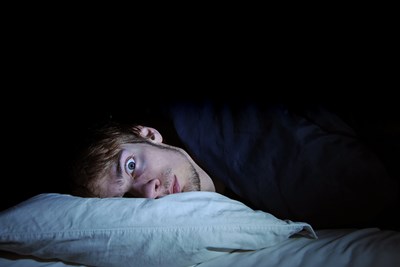Night terrors, or sleep terrors, are nighttime episodes of what effectively appears to be fits of terror -- several minute intervals of screaming, crying, thrashing about, and looking terrified, all while completely unconscious and generally leaving no memory of the event. The approximated 15% of children that experience sleep terrors generally outgrow them; it can be more difficult for the suspected 2% of adults, however, and particularly embarrassing. While they are fairly rare and not generally dangerous, night terrors that are exceptionally violent or chronic may require treatment to help them subside.
Physiological Treatments
Sleep terrors in adults can be indicative of an underlying medical condition -- particularly another sleep disorder, such as obstructive sleep apnea. Your doctor may recommend you take part in a polysomnogram, or sleep study, to help figure out exactly how to approach treatment if your night terrors are severely interruptive for you or your household’s nightly schedule. Additionally, since things like hyperthyroidism and encephalitis can influence night terrors, you may need a general physical exam and/or some blood work. From this point, treating the underlying condition may help treat your night terrors. For example, if you have sleep apnea you may need to sleep with a continuous positive airway pressure (CPAP) machine.
Psychological Treatments
If the underlying problem is related to stress or the presence of mental disorders such as depression, anxiety, or post-traumatic stress disorder (PTSD), it may be helpful to seek counseling from a licensed psychologist. According to the Mayo Clinic, types of therapy that can be extremely helpful for night terrors include cognitive behavioral therapy, hypnosis, biofeedback and relaxation therapy. Cognitive behavioral therapy (CBT) is intended to help clients meet realistic goals by learning to change unhealthy patterns, the way they think about themselves or the world, or the way they behave in particular situations, thus changing how they feel.
At Home Treatments
Medication is almost never used in children and very rarely in adults to manage night terrors. In very extreme situations, your doctor may recommend a benzodiazepine, which can help manage anxiety and help you get more sleep, although most benzodiazepines (such as clonazepam) are highly addictive. If you find that your night terrors are obnoxious and a little embarrassing, but you are otherwise perfectly healthy, there are a few easy tricks that can help with night terrors, including:
- Get plenty of sleep. This might mean taking a nap during the day or going to bed earlier at night. Whatever works for you to get a few extra hours of shut-eye so your body isn’t as exhausted at night.
- Relax in the evenings. Whether this means taking a bath, reading a book, or watching TV before going to bed (research has actually found TV isn’t necessarily detrimental if it helps you relax and actually catch some Zs), find a way to turn your mind off so you can focus on sleep.
- Don’t stress. While this can sound virtually impossible, it may be essential to managing your night terrors. Prioritize, meditate, or use positive imagery (like putting stressful things into a make believe box) before sleep. If your child seems to be having trouble dealing with stress or anxiety, talk to them about what’s wrong and how you can help -- it might help you all get more sleep!
- Plan for the worst. If all else fails, make sure your environment is safe to have night terrors in. The Mayo Clinic recommends locking windows and doors that lead outside, blocking stairs, and moving things you might trip over. You can rig alarms on gates and doors so that others in the house get woken up if you try to go for a midnight stroll. Keep knives or other weapons out of reach, and arrange for a low mattress to avoid falls getting out of bed.




